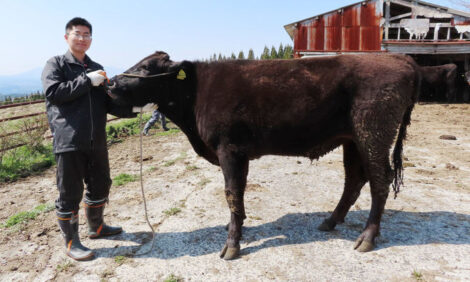



Using the Animal Unit Month (AUM) Effectively
By Alberta Agriculture and Food, Ropin The Web. The concept of the “Animal Unit Month” (AUM) has been useful in helping range and pasture managers work out suitable stocking rates for pastures under a wide variety of conditions.
To get the best production from the grass resource, it is important to understand how the AUM is defined. Such an understanding can help in determining stocking rates to produce the maximum returns without causing damage to the available grassland resources.
Animal Units
By definition, the AUM is the amount of forage needed by an “animal unit” (AU) grazing for one month. The quantity of forage needed is based on the cow’s metabolic weight, and the animal unit is defined as one mature 1,000 pound cow and her suckling calf. It is assumed that such a cow nursing her calf will consume 26 pounds of dry matter (DM) of forage per day (20 lbs for the cow and 6 lbs for the calf).
Various other types of stock are assigned AUM equivalents based on size and consumption. For example, a mature bull is the equivalent of 1.3 AU, a yearling steer or heifer is 0.67 AU and a weaned calf is 0.5 AU. These are equivalents established by the discussions of various agencies specializing in range management.
Adjustments
To establish accurate stocking rates, adjustments must be made to this basic definition of an AUM to arrive at reasonable forage disappearance rates, which include consumption levels, trampling and wastage by the cattle. These aspects must then be considered along with the forage production and desired residue levels on the land.
Animal Size
The Animal Unit does not accommodate the change in frame size of cattle where most crossbred beef cows weigh from 1,200 to 1,400 pounds. Cows in this weight range need from 23.0 to 25.6 pounds of DM, or 14 to 27 per cent more than the 1,000 pound cow. The larger calves consume proportionately more as well. Therefore, cows in the 1,200 to 1,400 pound weight range would be equivalent to from 1.11 to 1.21 of the basic Animal Unit.
Table 1 from the Dickinson Research Extension Center, North Dakota State University, shows that the change in metabolic requirement is not linear in relation to the weight of the animals. Rather, the requirement changes at a different rate than does the animal weight.
| Table 1. Animal Unit Equivalent (AUE) based on metabolic weight (live animal weight 0.75). | |
| Animal live weight(lbs) | Animal unit equivalent yx 0.75(% of 1,000 lbs) |
|---|---|
| 600 | 0.682 |
| 650 | 0.724 |
| 700 | 0.765 |
| 750 | 0.806 |
| 800 | 0.846 |
| 850 | 0.885 |
| 900 | 0.924 |
| 950 | 0.962 |
| 1,000 | 1.000 |
| 1,100 | 1.074 |
| 1,200 | 1.147 |
| 1,300 | 1.217 |
| 1,400 | 1.287 |
| 1,500 | 1.355 |
| 1,600 | 1.423 |
| 1,700 | 1.489 |
| 1,800 | 1.554 |
| 1,900 | 1.618 |
| 2,000 | 1.682 |
| 2,200 | 1.806 |
| 2,400 | 1.928 |
| 2,600 | 2.048 |
| 2,800 | 2.165 |
| 3,000 | 2.280 |
Consumption Rates
As shown in Table 2, the definition of the AUM provides an estimate of forage consumption to meet the metabolic requirements of cattle while on pasture. However, in pasture environments forage consumption rates can vary from as low as 1.5 per cent of body weight to as high as 3.5 per cent of body weight.
One of the main factors that affects consumption rates is forage quality. As forage plants mature, digestibility decreases. As a result, anticipate a higher level of forage intake in pastures composed of primarily vegetative growth versus more mature growth.
| Table 2 Calculating AUM (nutrient requirements of beef cattle, 1996) | |
| Daily forage dry matter intake (lb) | |
|---|---|
|
Average 1,000 lb cow producing 10 lb milk per day |
20.2 |
|
Extra energy needed by the calf from grazing* |
6.0 |
|
Total forage consumption |
26.2 |
|
Total for a month of 30.5 days |
799.1 |
|
* 10 lb of milk supplies about 25% of the energy needed for daily gain of 2.0 lb per day in a 300 lb calf |
|
Typically, early season growth or forage re-growth in managed grazing systems will provide the highest quality and, therefore, higher consumption rates. Forage growth in extensive grazing systems will provide more mature forage and, therefore, a lower level of forage consumption. Other factors such as animal age, physiological stage (dry, lactating) or supplementation level will also affect the level of pasture consumption.
For a more accurate stocking rate, adjustments should be made for both forage consumption and for other losses that occur within a grazing system. Animals will trample and spoil feed as they travel throughout a pasture. Weathering and forage senescence (aging) can also contribute to forage losses on pasture. As a result, the total forage disappearance on pasture will exceed the daily forage intake values listed in Table 2.
Management practices such as rotational grazing versus season-long grazing, pasture water systems or higher stocking densities may be used to increase forage consumption and minimize forage losses due to factors such as trampling and spoilage.
Summary
A land manager can use the AUM definition as a starting point in determining stocking rates, but must remember to make the necessary adjustments to animal size, consumption rates, trampling and spoilage effects to predict realistic disappearance rates. Coupling these aspects with reasonable estimates on forage production, both as initial growth and re-growth, it is possible to establish stocking rates for any given range or pasture.References
- Animal Unit Equivalent for Beef Cattle Based on Metabolic Weight. Llewellyn L. Manske PhD, Associate Range Scientist. North Dakota State University, Dickinson Research Extension Center 1089 State Avenue, Dickinson, ND 58601-4642
- Animal and plant response on renovated pastures in western Canada. Duane McCartney, John Waddington, Leonard Lefkovitch. Journal of Range Management 52(1), January 1999
- Natural Resources Conservation Services, Range and Pasture Technical Note Number MT-32 http://www.mt.nrcs.usda.gov/technical/ecs/range/technotes/rangetechnoteMT32.html


